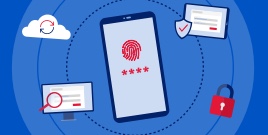Essential Lessons to Help Kids Stay Safe from Online Scams
Read, 4 minutes
Key takeaways
- A growing number of children and teens are falling victim to online fraud and scams
- Scammers prey on their inexperience, trust and fear of missing out (FOMO)
- Knowledge and good habits are powerful tools to spot and avoid scams
Children and teens have never known a world without the Internet. They spend hours online every day playing games, chatting with friends and scrolling social media. But while they may be tech-savvy, they aren’t life-savvy. Every year, thousands are victims of online fraud, scams and child identity theft that cost their families millions of dollars, according to the FBI’s Internet Crime Complaint Center. And those are just the ones who file reports. The actual numbers are much higher: One in 19 children has been affected by identity fraud since 2019, according to surveys by Javelin Strategy & Research.
This guide can help you have the necessary conversations with your children to protect them from fraud, identity theft, and deceptive online tactics.
What are common online scams targeting children?
Many online scams rely on psychological manipulation. Children are easy targets because they are more trusting and have less experience spotting threats. And because things move fast in games and on social media, it’s easy for them to act without thinking. Talk to your child about some of the most common scams, including:
Phishing is by far the most common crime reported by people of all ages to the FBI’s Internet Crime Complaint Center. In attacks aimed at children and teens, scammers send an email, text or pop-up message pretending to be a trusted source, such as a friend or an online game they’re playing.
The message encourages your child to click on a link to get a prize, take a quiz or resolve some urgent matter. The link typically goes to a fake website that asks for personal information, often including a credit card account, or installs malicious software.
Quick tip
Phishing messages are designed to look real and can be hard for children, or even adults, to spot. Teach your child to be suspicious if a text or email:
- Is unexpected
- Demands urgent action
- Has misspelled words or unnatural wording
- Comes from an unfamiliar phone number or an email address that is off by a couple of characters
Social media is the single biggest source of scams aimed at young people, the Federal Trade Commission says. Many phishing attacks originate there. Scammers often play on teens’ fear of missing out (FOMO), which can drive them to impulsively click a suspicious link. This is especially true if the link involves a social opportunity and comes from a sender they think is familiar, research shows. Contests, quizzes, surveys and giveaways, many pushed by fake influencer accounts, also present opportunities for scammers to collect personal information. Ads touting trendy items entice kids to click, then send them to fake websites that collect their personal information or take their money for a product that they never receive.
Many online games sell in-game currency, special powers or other extras to increase chances of winning or make playing more fun. Scammers take advantage of kids’ excitement by setting up fake ads or pop-up messages that offer add-ons at little or no cost. Children are enticed to disclose their personal and payment information or may click on links that load spyware or adware onto their devices.
Fake websites, ads or pop-up messages pitching popular merchandise at too-good-to-be-true prices lure children to “buy” the product and, in the process, give up their personal and payment information. But the product is never delivered, the money is lost and the child is at risk for identity theft.
Catfishing is when someone poses as a friend to gain a child’s trust and then manipulates them into sharing personal information, giving money or sending compromising photos. It may start with a friend or follow request on social media or in multiplayer game chat. The catfisher will compliment the child on a post or how they play a game and ask to move the conversation to a private platform, such as texting or direct messaging. In the worst cases, continuing conversations can lead to child sexual exploitation.
How can I help my child avoid online fraud and scams?
Good online habits go a long way in helping children and teens avoid online scams. Knowledge is power. Keep your children informed, encourage conversations and monitor their social and gaming habits frequently. Providing older kids with real life examples of recent scams, rather than generalities, will bring situations to life and help strengthen their radar. Most of all, keep the lines of communication open so children feel comfortable sharing what they’re seeing online. Here are some basic tips to share with children:
Never open links or download attachments from unknown sources, even if they look official.
If someone online offers something for free or asks for personal details, double-check their identity with a trusted adult.
Don’t share full names, addresses, phone numbers, passwords or financial information. Use made-up names in virtual worlds.
Create strong passwords and use two-factor authentication.
If an online deal or giveaway seems amazing, it’s likely a scam.
What should I do if my child falls victim to a scam?
Start by providing emotional support to your child. Falling for a scam can be embarrassing, confusing and scary. Assure your child that it can happen to anyone and focus on ways to prevent it in the future. Keep the conversation going by discussing what your child is doing online, the latest scams and good digital habits. Then take these concrete steps to limit potential damage:
- Act quickly after an incident, as it can help minimize damage.
- Change all passwords that may have been compromised.
- Call the police and file reports with the relevant local authorities. Many state attorney general websites have detailed information on the latest scams, and online forms to file a consumer complaint.
- File reports with the FBI's Internet Crime Complaint Center. Report child sexual exploitation to the National Center for Missing and Exploited Children.
- Document everything about the incident. The more information you have, the better armed you will be to assist an investigation by law enforcement officials.
- Alert your bank about the scam. Although recovering lost money isn’t possible in most cases, your bank may be able to use the information to warn other clients.
- Freeze your child’s credit report by contacting each of the three credit bureaus — Experian, Equifax and TransUnion. This makes it hard for someone to open accounts in your child’s name.
FAQ
An early sign is questionable charges on your credit card or bank accounts. If their identity has been stolen, you may:
- Get pre-approved credit card offers in their name
- Be contacted by the IRS or other government agency about their Social Security number being used on a tax return or to apply for benefits
- Try to open a bank account for them only to learn one already exists



